Photos with this report (click to enlarge) | |||
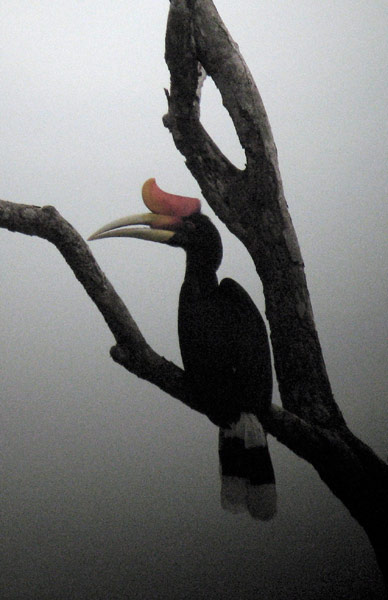 Rhinoceros Hornbill |
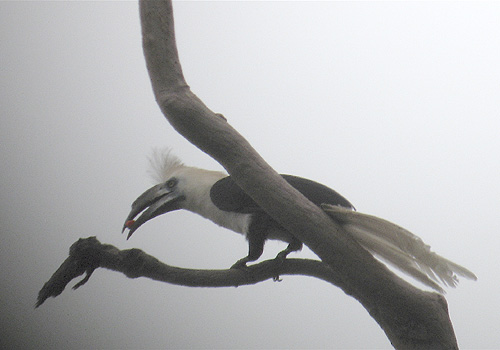 White-crowned Hornbill |
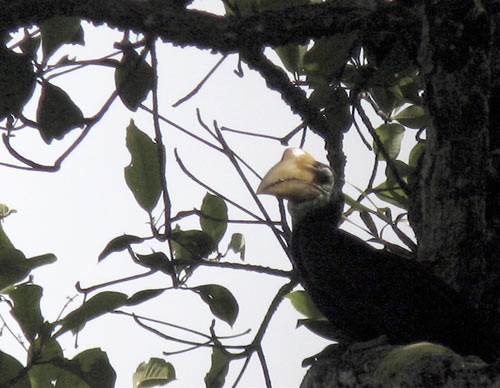 Wrinkeled Hornbill |
|
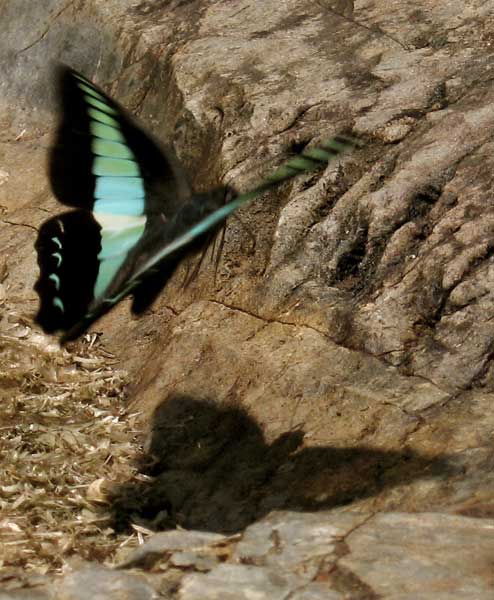 Blue Triangle AKA Blue Bottle - Graphium sarpedon |
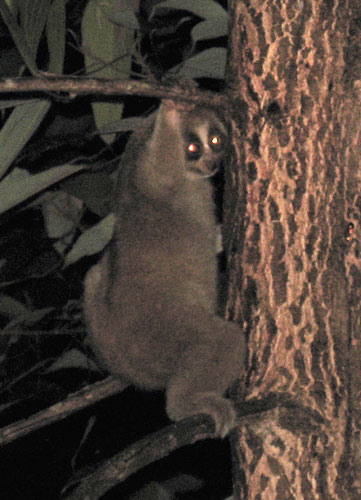 Sunda or Slow Loris |
||
Tasik (Lake) Kenyir is a large hydroelectric reservoir in west Malaysia surrounded by primary and selectively logged lowland forest. Two roads cut through the forest, providing excellent opportunities to view canopy-dwelling birds. On June 22, 2007 we saw nine hornbill species here --White-crowned, Bushy-crested, Wrinkled, Wreathed, Black, Oriental Pied, Rhinoceros, Great and Helmeted.
During our longer stay at the lake (June 22-25) we saw, in addition to the hornbills, Oriental Honey Buzzard, Bat Hawk, White-bellied Sea-Eagle, Lesser Fish-Eagle, Crested Serpent-Eagle, Crested Goshawk, Rufous-bellied Eagle, Changeable Hawk-Eagle, Blyth’s Hawk-Eagle, Wallace’s Hawk-Eagle and Black-thighed Falconet. Within the forest itself we found Large Green Pigeon, Violet Cuckoo, Red-bearded Bee-eater, Great Slaty Woodpecker, Puff-throated Babbler, Pale Blue Flycatcher and Great and Green Iora. A Tiger roaring nearby, as well as daily sightings of White-handed Gibbon and night encounters with Leopard Cat and Sunda Loris added to the experience. Kenyir’s roads complement the deep forest trails in Taman Negara, revealing birds difficult to glimpse within the park itself. This site would make an excellent addition to the itineraries of birders visiting or living in Malaysia.
Getting There - Tasik Kenyir is in Terengganu, a state on the east coast of peninsular Malaysia. The lake is an hour’s drive inland from coastal Kuala Terengganu (KT), the state capital. From KT take Route 3 north towards Kota Bahru. Approximately 30 km from KT near Sungai Tong, Setiu, turn left onto Route T11. Follow this for almost 20 km. Just before Kampung Kuala Ping, turn right onto Route T156. A further 12 km along this road you reach the exit for the lake’s main jetty (Pengkalan Gawi Jetty) on your left. Signs to the lake are prominent along the entire route.
KT will soon be linked directly to Kuala Lumpur by a four-lane highway. Driving time is now five hours on the almost complete road. In the very near future birders will also be able to drop down from Cameron Highlands on the west side of the peninsula on the new Gua Musang-Terengganu highway.
Accommodations - The Lake Kenyir Resort and Spa (www.lakekenyir.com) is close to the main birding areas and is making a special effort to develop the eco-tourism potential of Kenyir. Consisting of a beautiful reception/dining/pool area and a series of large, comfortable chalets, we stayed here June 22, 23 and 24, paying RM250/night for our package (which included breakfast). Because the resort is built on hilly ground, golf carts shuttle guests from the parking lot to the reception and chalets. To get to the resort follow the instructions above to the Pengkalan Gawi Jetty and you cannot miss the signs to the resort itself.
Birding Kenyir from Kuala Terengganu is also a possibility. A 5:30am departure from the city puts you at the hornbill areas just as dawn breaks, an ideal time. Accommodations north of KT along the coast include The Sutra Beach Resort (good value at a moderate price) and The Aryani (a beautiful luxury retreat).
Transportation - A vehicle is essential at Kenyir, the area cannot be effectively birded on foot alone. We rented a small sedan at the reasonable cost of RM140 per day from Kapas Travel and Tours at the main airport in KT. For an additional RM60 the company agreed to drop it off and pick it up from the resort -- a very good deal. Having our own car contributed greatly to our birding success, it was also an opportunity to experience right hand drive. Sticking to the correct lane on the nearly empty roads was surprisingly easy, finding the gear shift and distinguishing between turn signals and wipers was more challenging. Because there are no gas stations near the resort it is important to arrive with a full tank.
Seeing Hornbills - Hornbills are large and charismatic birds, with striking bill and plumage features as well as varied and distinctive vocalizations. Lacking the small under-wing feathering of other bird species, the hornbill’s flight produces a tremendous rushing sound with each wing beat; audible up to a kilometre away. Adding to their allure, some hornbills are rare and others, even when relatively common, can be difficult to see in the tree tops from the forest floor. At Kenyir the Main and Waterfall roads alleviate this problem, allowing even distant birds to be seen and studied.
Hornbills are most active early in the morning and late afternoon, flying to and from feeding and roosting areas. To pick them out we would walk and drive the roads, stop at open viewing points and scan the skyline and tall dead trees. In areas where the forest encroached closer and sightlines were restricted we would listen for their vocalizations. If we were patient, calling birds would often reveal themselves. We were also alert for the distinctive sound of hornbills in flight - a steady Woof! Woof! Woof! Woof! Woof! As the sound of wing-beats approached we would scramble to position ourselves under the presumed flight path and, if lucky, would see the bird emerge overhead from the forest. Hornbills typically travel in groups, so even if we only caught a glimpse of one disappearing into the trees we would keep watching. Frequently one, two, three or more birds would follow shortly thereafter.
There are no guarantees in birding, but it is a good bet that a couple days spent searching for hornbills at Kenyir will yield results. On June 22, 2007 we were able to see all nine of the locally occurring species, each one scoped and studied at leisure as they perched in the forest. More typically we would see five to six species a day. Bushy-crested, Wreathed, Black, Oriental Pied, Rhinoceros and Great are the commonest. Helmeted were frequently heard, although they are wary and difficult to get a look at. White-crowned and Wrinkled are globally the rarest, but we were able to see them on two of our four days at Kenyir.
Birding Locations
The Lake Kenyir Resort grounds feature an array of ornamental plantings, open secondary forest and old oil palm plantation regenerating into more natural habitat. Emerald Dove, Linneated Barbet and Puff-throated Babbler were frequently seen and heard around the chalets. The restaurant/pool area overlooks the lake and provides a place to watch various swifts and the occasional raptor (including Grey-headed Fish-Eagle) cruise by at eye level. One evening as we dined a Great Hornbill roared in above us and landed in a nearby tree to roost. On several occasions we had Oriental Pied Hornbill here as well.
The Main Road (a continuation of Highway T156) runs 25 kilometres through selectively logged forest from the Pengkalan Gawi Jetty junction to a bridge and the “Angler’s Paradise” fishing lodge. As of August 2007 the pavement ends at the bridge but very soon the entire length will be paved through to Gua Musang, Kelantan, increasing traffic but allowing access to the Kenyir area directly from the west side of the peninsula. Our strategy was to arrive at dawn (6:30am) and drive the road to the bridge, stopping and scanning for hornbills and raptors. A telescope was essential.
Along most of the road the forest is set well back and there is little shade. The distance to the tree line makes it difficult to search for small perching birds but at regular intervals tracks run off from the pavement, providing some access to the scrubbier roadside forest. From the junction of the Main Road and the Pengkalan Gawi Jetty Road, trails can be found leading off the Main Road at:
Kilometre 1.8 - Waterfall Road Junction (see below)
Kilometre 12.3 - paved secondary road (excellent birding, runs a couple kilometres to a major washout)
Kilometre 18.3 - gravel side road
Kilometre 20.6 - gravel side road
Kilometre 22.1 - gravel side road
Kilometre 25 - bridge
Construction equipment and logging trucks are present on the Main Road. The Orang Asli, Malaysia’s aboriginal people, are here as well and the signs of their temporary camps are visible at some of the roadside clearings.
The Waterfall Road is reached by taking a left turn off the Main Road 1.8 kilometres west of the Pengkalan Gawi Jetty junction. It runs several kilometres along the lakeshore, past the Sungai Buweh waterfall and ends at a pump-house at the water’s edge. The initial section is very open but the forest begins to close in after the road passes a transformer substation on the right. In contrast to the Main Road, the forest birding is good. Sightings near the parking pull-offs included Buffy Fish Owl, Black-bellied Malkoha and Buff-rumped Woodpecker. Chestnut-naped Forktail are seen at the waterfall itself.
At the point where the road crosses a concrete culvert we had excellent looks at White-crowned Hornbill and White-handed Gibbon. Red-bearded Bee-eater, Violet Cuckoo and Great Iora were seen a little further along near a small quarry on the right. Continuing on, the road curves downhill into the shaded valley of a small river and then climbs steeply. At the top of the hill the road divides -- straight downhill to the pump-house and the lakeshore; right uphill past a waterworks to a plateau of secondary forest. On our ascent to the plateau we had Large Green Pigeon and Wrinkled Hornbill and, at the top, Oriental Honey Buzzard. This road continues on to eventually connect with the Main Road at K12.3, but cannot be driven through because of a major washout. Our best walk of the visit consisted of parking at dawn at the concrete culvert and walking to the high plateau and back.
Boat Trip to Taman Negara - On June 23 we took a speedboat across Lake Kenyir into Taman Negara. The excursion was arranged through the resort and cost RM700. We departed at 8:30am and returned at approximately 2:00pm. Our main destination was the Bewah Cave.
The boat ride was scenic but birdless. After an hour and a half we crossed into Taman Negara, docked at the base of a large cliff and climbed a series of steps to the cave. House swifts swirled around the opening and the rank odor of bat filled the air. Following a boardwalk deeper into the darkness we came to a huge cavern buttressed by flowing rock formations. The ground was crawling with strange crickets and huge green spiders.
Next stop was a beautiful campground on a small peninsula nearby. A pair of Blue Rock Thrush were at the tip of the point. From the back of the camping area we followed a path into the forest to a rock face dripping with water where we surprised a Chestnut-naped Forktail. As we made our way back to the campground the air suddenly shook with a tremendous roar that sounded like two long bursts from a blast furnace. One of our guides looked at us, said “stripe” and quickly returned to the boat. He estimated that the Tiger was perhaps 500 metres away - not as good as an actual sighting, but still a memorable experience.
Other Birding Locations in Terengganu include the Setiu Wetland (home of Lesser Adjutants), the Perhentian islands (Nicobar and Pied Imperial Pigeon and great snorkeling), the Kertih Mangroves (accessible Mangrove Pitta) and the secondary forest around Kuala Terengganu (Rufous Piculet to Great Hornbill). My friend Anuar Abdullah Con McAfee, who has pioneered hornbill watching at Kenyir and is working hard to popularize birding in Terengganu, is a good contact and/or guide for visitors to the state (anuarmcafeeATudm.edu.my).
1. Oriental Honey Buzzard - Pernis ptilorhynchus - One, off the Waterfall Road on the trail above the waterworks - In contrast to the hornbills who were very active at dawn, the best time for raptors was later in the morning once the air warmed up
2. Bat Hawk - Macheiramphus alcinus - One at dawn, K25 of the Main Road (at the bridge)
3. White-bellied Sea-Eagle - Haliaeetus leucogaster - One at dawn, K25 of the Main Road (at the bridge)
4. Lesser Fish-Eagle - Ichthyophaga humilis - One from the boat at the Taman Negara boundary
5. Crested Serpent-Eagle - Spilornis cheela - The commonest raptor, seen daily along Main and Waterfall roads
6. Crested Goshawk - Accipiter trivirgatus - Two separate sightings along the Main Road, both were initially perching and then engaged in a wing-flickering display flight
7. Rufous-bellied Eagle - Hieraaetus kienerii - Two sightings, one soaring, one perched, both along the Waterfall Road near the river crossing, a handsome bird
8. Changeable Hawk-Eagle - Spizaetus cirrhatus - One along the Main Road
9. Blyth’s Hawk-Eagle - Spizaetus alboniger - One soaring along the Waterfall Road
10. Wallace’s Hawk Eagle - Spizaetus nanus - One, perched near the Red-bearded Bee-eater Quarry on the Waterfall Road - there are peculiar and not completely understood similarities in appearance between this bird, Oriental Honey Buzzard and Jerdon’s Baza
11. Black-thighed Falconet - Microhierax fringillarius - Regular along the Main and Waterfall Roads, invariably atop a dead tree, always surprisingly small
12. Red Junglefowl - Gallus gallus - Males heard crowing along the Main and Waterfall Roads, one female seen along the Main Road at the K20.6 pull off
13. Great Argus - Argusianus argus - Heard daily along the Main and Waterfall Roads
14. Thick-billed Pigeon - Treron curvirostra - One flock of eight off the Main Road on the K12.3 turnoff
15. Little Green Pigeon - Treron olax - Seen daily along Main and Waterfall Road, lone individuals or small groups
16. Large Green Pigeon - Treron capellei - Two early morning sightings along the Waterfall Road, one female, one pair, both perched atop dead trees
17. Emerald Dove (Green-winged Pigeon) - Chalcophaps indica - Seen daily at the resort and along both roads
18. Spotted Dove - Streptopelia chinensis - Seen daily in open, disturbed areas
19. Peaceful Dove - Geopelia striata - See above
20. Blue-crowned Hanging-parrot - Loriculus galgulus - Seen or heard daily
21. Indian Cuckoo - Cuculus micropterus - Heard daily
Oriental Cuckoo - a hepatic female cuckoo seen along the Waterfall Road fit the description for this bird (sharp demarcation between heavily barred upper chest and less marked lower breast and belly)
22. Plaintive Cuckoo - Cacomantis merulinus - Heard daily
23. Drongo Cuckoo - Surniculus lugubris - Heard daily, two sightings
24. Violet Cuckoo - Chrysococcyx xanthorhynchus - One seen, high a top a dead tree, Waterfall Road at the Bee-eater quarry
25. Common Koel - Eudynamys scolopacea - Heard daily
26. Black-bellied Malkoha - Phaenicophaeus diardi - Two along Waterfall Road
27. Chestnut-bellied Malkoha - Phaenicophaeus sumatranus - One along Waterfall Road
28. Greater Coucal - Centropus sinensis - Heard daily, one seen at pump-house
29. Buffy Fish Owl - Ketupa ketupu - One seen on the Waterfall Road 8:30am perched by the roadside under the over-hanging canopy, just past the substation
30. Large-tailed Nightjar - Caprimulgus macrurus - Heard nightly around the resort
Aerodramus swift - Swiftlets of this genus seen daily but not identified
31. Asian Palm Swift - Cypsiurus balasiensis - Seen daily, usually around the resort
32. Silver-rumped Swiftlet - Rhaphidura leucopygialis - Seen daily, low over the forest
33. House Swift - Apus affinis - Seen daily
34. Grey-rumped Treeswift - Hemiprocne longipennis - Seen daily
35. Whiskered Treeswift - Hemiprocne comata - Seen daily, including great scope views along the Waterfall Road
36. White-throated Kingfisher - Halcyon smyrnensis - Seen daily
37. Blue-throated Bee-eater - Merops viridis - Seen daily
38. Red-bearded Bee-eater - Nyctyornis amictus - Three heard and called in along the Waterfall Road, at the quarry on the right past the concrete culvert
39. Dollarbird - Eurystomus orientalis - Seen daily
40. Bushy-crested Hornbill - Anorrhinus galeritus - Perhaps the commonest hornbill at Kenyir, raucous calls heard daily, groups of five to seven frequently seen as well, usually in flight as perhaps this species prefers to feed inside the canopy
41. Wrinkled Hornbill - Aceros corrugatus - Two sightings of this rarer hornbill, a pair on the Main Road, a single male on the Waterfall Road near the waterworks
42. White-Crowned Hornbill - Berenicornis comatus - Another rarer hornbill, a group of three was seen on two days at the same location - Waterfall Road just past the waterfall - we first heard their pigeon-like hooting but could not see them in the canopy - patience paid off as they eventually presented themselves for stunning views - the wings of this species seem anomalously quiet
43. Wreathed Hornbill - Rhycticeros undulates - Seen daily along Main and Waterfall Road, the wings of this species are very noisy, one on a long glide path overhead made a continuous buzz that sounded like a small plane
44. Black Hornbill - Anthracoceros malayanus - Seen and heard daily along the Main and Waterfall Roads, braying call very distinctive
45. Oriental Pied Hornbill - Anthracoceros albirostris - Three sightings, two at the resort but a pair also seen at the Bewah Cave
46. Rhinoceros Hornbill - Buceros rhinoceros - Daily along both roads - on evening drives back to the resort on the Main Road it was often seen perching close by in tall dead trees - loud trumpet-like honking call distinctive, but this species also gave harsher calls indistinguishable to my ears from Great Hornbill
47. Great Hornbill - Buceros bicornis - Three sightings, one at the resort, two off the Main Road on the K12.3 turnoff, produces a loud, harsh honking call
48. Helmeted Hornbill - Rhinoplax vigil - One seen off the Main Road on the K12.3 turnoff, looks like a gigantic butterfly in flight, also heard daily: hoo….. hoo….. hoo….. hoo…. hoo…. hoo…. hoo… hoo…hoo…hoo... ha.. ha.. ha.. ha.. ha.. ha.. ha.. ha.. A-A-A-A-A-A-A-A-A-A-A-A!
49. Lineated Barbet - Megalaima lineate - Heard and seen daily around the resort
50. Red-throated Barbet - Megalaima mystacophonos - Heard daily, one seen
51. Blue-eared Barbet - Megalaima australis - Heard daily
52. Yellow-crowned Barbet - Megalaima henricii - Heard daily along the Waterfall Road, several seen
53. Great Slaty Woodpecker - Mulleripicus pulverulentus - One seen off the Main Road on the K12.3 turnoff
54. Common Goldenback - Dinopium javanense - One, at the resort
55. Buff-necked Woodpecker - Meiglyptes tukki - Two sightings
56. Buff-rumped Woodpecker - Meiglyptes tristis - One, Waterfall Road at last parking lot
57. Gray and Buff Woodpecker - Hemicircus concretus - One sighting, a nest building pair along the Main Road
58. Black and Yellow Broadbill - Eurylaimus ochromalus - A pair, Waterfall Road at bridge, also heard along Waterfall Road and Main Road
59. Pacific Swallow - Hirundo tahitica - Common
60. Scarlet Minivet - Pericrocotus flammeus - Two sightings
61. Green Iora - Aegithina viridissima - Seen daily along the Main and Waterfall Roads, a nice looking bird
62. Common Iora - Aegithina tiphia - Common around resort
63. Great Iora - Aegithina lafresnayei - One sighting of a male along the Waterfall Road just past the waterfall, a big and crisp yellow and black bird, responded to playback
64. Lesser Green Leafbird - Chloropsis cyanopogon - Two sightings, Waterfall Road
65. Blue-winged Leafbird - Chloropsis cochinchinensis - Three sightings, Waterfall Road
66. Black-headed Bulbul - Pycnonotus atriceps - Up to 20 seen daily, Main and Waterfall Roads
67. Grey-bellied Bulbul - Pycnonotus cyaniventris - Three sightings along the Main and Waterfall Roads, observed carefully to avoid confusion with grey morph Black-headed Bulbul
68. Stripe-throated Bulbul - Pycnonotus finlaysoni - Very common
69. Yellow-vented Bulbul - Pycnonotus goiavier - Abundant
70. Olive-winged Bulbul - Pycnonotus plumosus - One, Waterfall Road
71. Cream-vented Bulbul - Pycnonotus simplex - Four sightings, Waterfall Road
72. Red-eyed Bulbul - Pycnonotus brunneus - Seen daily
73. Spectacled Bulbul - Pycnonotus eyrthrophthalmos - Two sightings, Waterfall Road
74. Grey-cheeked Bulbul - Alophoixus bres - One sighting, Waterfall Road
75. Yellow-bellied Bulbul - Criniger phaeocephalus - Two sightings, Waterfall Road
76. Hairy-backed Bulbul - Hypsipetes criniger - One sighting, Waterfall Road
77. Buff-vented Bulbul - Hypsipetes charlottae - One sighting, Waterfall Road
78. Greater Racket-tailed Drongo - Dicrurus paradiseus - Seen and heard daily
79. Dark-throated Oriole - Oriolus xanthonotus - Three sightings along Waterfall Road
80. Black-naped Oriole - Oriolus chinensis - Seen daily around the resort and on the first stretch of the Waterfall Road
81. Asian Fairy Bluebird - Irena puella - Seen daily
82. Crested Jay - Platylophus galericulatus - Seen on two days on Waterfall Road, just past the waterfall
83. Black Magpie - Platysmurus leucopterus - Seen and heard daily along the Main Road, the side road at K12.3 was a particularly good spot for this species
84. Large-billed Crow - Corvus macrorhynchos - Three, Taman Negara border
85. Velvet-fronted Nuthatch - Sitta frontalis - One family group, Waterfall Road near the waterfall
86. Puff-throated Babbler - Pellorneum ruficeps - Heard and seen daily around the chalets
87. Abbott´s Babbler - Trichastoma abbotti - Heard daily
88. Short-tailed Babbler - Malacocincla malaccensis - One seen, Waterfall Road, river crossing
89. Striped Tit-babbler - Macronous gularis - Common in edge habitat, difficult to glimpse
90. Blue Rock Thrush - Monticola solitarius - A pair at the campground near the Bewah Cave, tip of the peninsula
91. Oriental Magpie-robin - Copsychus saularis - Common at the resort and along open areas of both roads
92. White-rumped Shama - Copsychus malabaricus - Heard and seen daily along both roads
93. Chestnut-naped Forktail - Enicurus ruficapillus - One, a very nervous bird at the end of the campground trail near the Bewah Cave
94. Dark-necked Tailorbird - Orthotomus atrogularis - Seen daily
95. Ashy Tailorbird - Orthotomus sepium - Seen daily
96. Rufous-tailed Tailorbird - Orthotomus sericeus - One sighting, a family group along the Waterfall Road at the river crossing
97. Rufescent Prinia - Prinia rufescens - Several sightings in the roadside scrub, Main Road
98. Pale Blue Flycatcher - Cyornis unicolor - A pair were seen early morning in the roadside understory at K25 of the Main Road (just past the bridge)
99. Grey-headed Flycatcher - Culicicapa ceylonensis - Two, Waterfall Road
100. Philippine Glossy Starling - Aplonis panayensis - Flock of six near the resort
101. Common Myna - Acridotheres tristis - Seen daily
102. Jungle Myna - Acridotheres fuscus - Smallish mynas were identified as this species, but only a minority of them had blue bill bases
103. Hill Myna - Gracula religiosa - Seen and heard daily
104. Brown-throated Sunbird - Anthreptes malacensis - Nesting near the resort
105. Purple-naped Sunbird - Hypogramma hypogrammicum - One, Waterfall Road
106. Little Spiderhunter - Arachnothera longirostra - One, Waterfall Road
107. Grey-breasted Spiderhunter - Arachnothera affinis - Two sightings, Waterfall Road
108. Yellow-breasted Flowerpecker - Prionochilus maculatus - One, Main Road
109. Crimson-breasted Flowerpecker - Prionochilus percussus - One, Main Road
110. Orange-bellied Flowerpecker - Dicaeum trigonostigma - One, Main Road
111. Yellow-vented Flowerpecker - Dicaeum chrysorrheum - Two, Main Road
112. Oriental White-eye - Zosterops palpebrosus - Two flocks, Waterfall Road
113. White-rumped Munia - Lonchura striata - Three sightings, Waterfall Road
114. White-bellied Munia - Lonchura leucogastra - Seen daily along the Waterfall Road in small groups of three to six, olive edges to the tails very distinctive
Annotated Mammal List
Asian Elephant - Elephas maximus - One driving by on a barge on the lake, a “bad” elephant removed from agricultural land and being relocated to a wilder area
1. Sunda Loris - Nycticebus coucang - Close views on the Waterfall Road, just past the concrete culvert - located at night by its eyeshine, appeared to be feeding on sap dripping from a tree
2. Long-tailed Macaque - Macaca fascicularis - Frequently seen along the roads
3. Dusky Languar - Trachypithecus obscurus - Troops seen daily, crashing noisily about in roadside trees, quite wary and would flee deeper into the forest upon seeing us
4. Banded Languar - Presbytis femoralis - One troop of dark-faced languars along the Waterfall Road was presumably this species - a distinctive, loud staccato chatter heard at night along the same road matched the vocalization description for this animal as well
5. White-handed Gibbon - Hylobates lar - Spectacular looping calls a signature lowland forest sound - also seen every day, moving slowly and gracefully through the branches, a calmer animal than the languars, requiring a bit more patience to spot
6. Plaintain Squirrel - Callosciurus notatus - Seen daily
7. Prevost’s Squirrel - Callosciurus prevosti - One seen low in a tree on a little side track off the Main Road, a beautiful rodent - boldly marked with white, black and orange
8. Malayan Flying Fox - Pteropus vampyrus - Two or three feeding at night in a tall fruiting tree at the resort
9. Leopard Cat - Prionailurus bengalensis - Three sightings of this spectacularly beautiful and graceful little cat, all at night - two were on the main road (one fleeting view and one close study of an individual that allowed us to get out of the car and approach it), the other was seen on the Waterfall Road past the culvert as we walked it at night, again it allowed us to approach it closely as it sat in an open area - interestingly this strongly spotted cat appeared uniformly dark until seen well
Leopard - Panthera pardus - Largish cat tracks seen on a logging trail off the Main Road might have been this species
10. Tiger - Panthera tigris - One heard roaring close by from the campsite near the Bewah Cave
11. Palm Civit - Paradoxurus hermaphroditus - Two, both at night, one seen in the moderate distance working along the lake shore at the resort, the other in our car’s headlights on the acces road to the resort
Malayan Tapir - Tapirus indicus - Tracks frequently seen on the trails leading off the Main Road
12. Eurasian Wild Pig - Sus scrofa - Several seen at night around the resort, one also seen towards the end of the Waterfall Road
13. Common Muntjac (Barking Deer) - Muntiacus muntjak - One seen early morning along the Waterfall Road near the waterworks